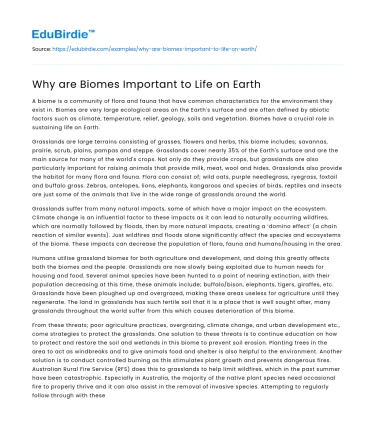A biome is a community of flora and fauna that have common characteristics for the environment they exist in. Biomes are very large ecological areas on the Earth's surface and are often defined by abiotic factors such as climate, temperature, relief, geology, soils and vegetation. Biomes have a crucial role in sustaining life on Earth.
Grasslands are large terrains consisting of grasses, flowers and herbs, this biome includes; savannas, prairie, scrub, plains, pampas and steppe. Grasslands cover nearly 35% of the Earth's surface and are the main source for many of the world's crops. Not only do they provide crops, but grasslands are also particularly important for raising animals that provide milk, meat, wool and hides. Grasslands also provide the habitat for many flora and fauna. Flora can consist of; wild oats, purple needlegrass, ryegrass, foxtail and buffalo grass. Zebras, antelopes, lions, elephants, kangaroos and species of birds, reptiles and insects are just some of the animals that live in the wide range of grasslands around the world.
Grasslands suffer from many natural impacts, some of which have a major impact on the ecosystem. Climate change is an influential factor to these impacts as it can lead to naturally occurring wildfires, which are normally followed by floods, then by more natural impacts, creating a ‘domino effect’ (a chain reaction of similar events). Just wildfires and floods alone significantly affect the species and ecosystems of the biome. These impacts can decrease the population of flora, fauna and humans/housing in the area.
Humans utilise grassland biomes for both agriculture and development, and doing this greatly affects both the biomes and the people. Grasslands are now slowly being exploited due to human needs for housing and food. Several animal species have been hunted to a point of nearing extinction, with their population decreasing at this time, these animals include; buffalo/bison, elephants, tigers, giraffes, etc. Grasslands have been ploughed up and overgrazed, making these areas useless for agriculture until they regenerate. The land in grasslands has such fertile soil that it is a place that is well sought after, many grasslands throughout the world suffer from this which causes deterioration of this biome.
From these threats; poor agriculture practices, overgrazing, climate change, and urban development etc., come strategies to protect the grasslands. One solution to these threats is to continue education on how to protect and restore the soil and wetlands in this biome to prevent soil erosion. Planting trees in the area to act as windbreaks and to give animals food and shelter is also helpful to the environment. Another solution is to conduct controlled burning as this stimulates plant growth and prevents dangerous fires. Australian Rural Fire Service (RFS) does this to grasslands to help limit wildfires, which in the past summer have been catastrophic. Especially in Australia, the majority of the native plant species need occasional fire to properly thrive and it can also assist in the removal of invasive species. Attempting to regularly follow through with these solutions could save this incredible biome from perishing.






 Stuck on your essay?
Stuck on your essay?

